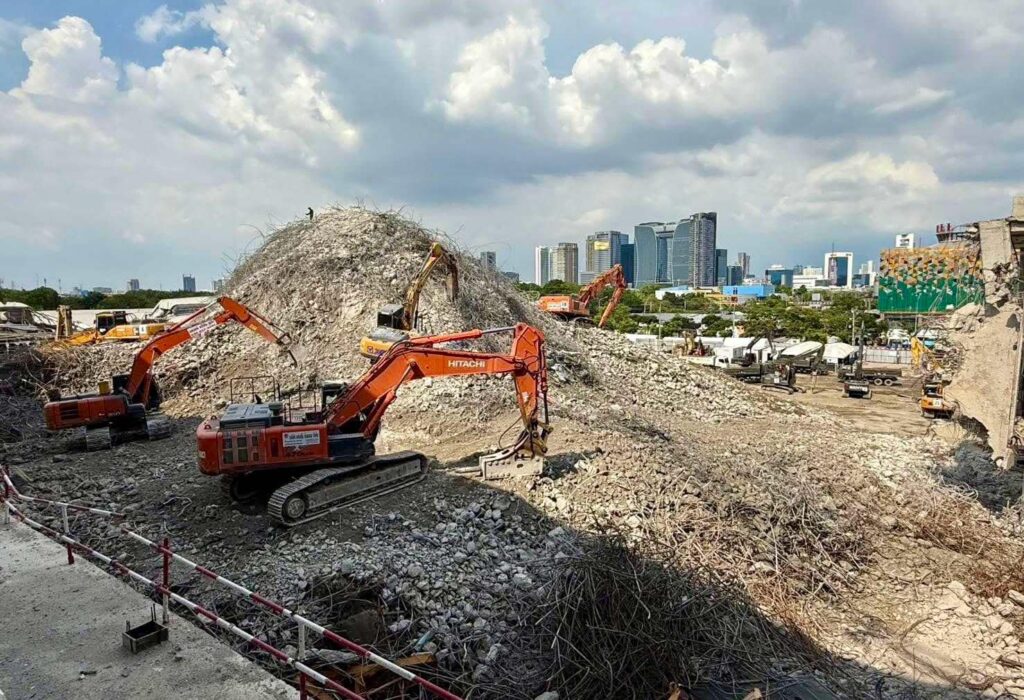The design of its critical core walls and core lifts, widely acknowledged as the skeleton of a building, was also adjusted, prompting speculation that this had critically contributed to what engineers call “a total collapse” of the SAO building
The building design issue was revealed by a representative from the Council of Engineers Thailand (COE) during the meeting of the Lower House’s standing committee on budget monitoring, which on Thursday had invited concerned parties including the State Audit Office (SAO) to respond to its inquiries. The COE is another third-party appointed by the government last week to investigate the collapse of the SAO building and present its findings along with other established engineering institutions within 90 days. (Read: Suspicions in collapsed SAO building raised “from the start” and through “construction process”: PM)
The representative told the meeting that following an initial examination by his team, they found that the design of the building was “not in line” with the Building Codes under the ministerial regulation B.E. 2550 (2007).
The 2007 ministerial regulation was developed under the Building Code Act B.E. 252,2 following the 2004 tsunami to address major earthquakes and their impacts after the tsunami incident, which had caused extensive loss and damage to the country. Unprecedented seismic building codes and standards against earthquakes were then introduced in 2007 and 2018. The regulation was also revised in 2021 to improve earthquake-resistant designs and engineering.
The representative stressed that the regulation and the existing building codes and standards are valid to deal with earthquakes. But the team has found “irregularities” in the design and construction from the first floor to the middle of the height of the building.
At this point, they will not yet conclude that the design did not abide by the law or violated it, nor will they conclude that this is a prime cause of the collapse of the building because further investigation is needed, he said.
“Normally, we will see first if a building is normal or irregular. There are at least 16 points to check for irregularities in building designs and constructions, and based on our calculations, we have found some of those from the first floor to the middle of the height of the building. So, at this point, we said it’s “not in line” with the regulation. This does not mean they contributed to the collapse of the building either. We need to look into more detail,” said the COE’s representative, in response to an inquiry posted by the committee’s Chair, MP Surachet Pravinvongvuth of the People’s Party, also a civil engineer.
Core Walls
According to Deputy Auditor General Sutthipong Boonnithi and his staff, who presented the information about the construction project to the committee, the SAO planned to build a new building to receive over 2,400 staff from 50 units in Bangkok. So, it’s a building of special height, 30 storeys, and a use area of 82,000 square metres.
From early 2020 to 2022, the SAO had recruited a building designer, a construction supervisor or consultant, and a construction builder. A joint venture of Forum Architect and Meinhardt (Thailand) won a contract worth Bt 73 million to design the building, a PKW joint venture won a contract worth Bt 74.6 million to supervise the construction, and the ITD-CREC joint venture won a contract to build the building. This’s worth Bt 2,136 million, around Bt 386 million or 18% below the middle price set by the SAO at around Bt 2,522 million.
According to the SAO’s representatives, the builder raised the issue concerning the design of the building, especially the load factor. The SAO then learned later that the building designer had applied the seismic building codes and standards of the Engineering Institute of Thailand (EIT), which were not mandatory. So, it called for a meeting with the experts and authorities concerned to ask for advice. It then called on the designer to make an assurance that the design of the building complied with the law.
The SAO was later confirmed by the designer that the design was improved and it had complied with the 2007 ministerial regulation. The earthquake resistance forces were also increased, although not maximised.
According to the conditions set by the SAO, the construction supervisor will help review details of the design as well as construction work and approve them for the contract management and construction supplies acceptance committee. This allows the SAO to rest assured about the construction work of its new building.
However, the SAO had to adjust the work and the contract nine times over the period. The critical ones were about Covid-19 and the work on the core walls and core lifts of the building.
According to the SAO, it was learned later that the design did not reserve some extra space for installation of electrical systems and interior designs around core walls and core lifts that would prompt the shrinking of the space and the failure in law compliance, especially the mandatory width of walkways around core lifts at 1.5 m at least.
The building designer decided to adjust the sizes of the beams and the thickness of core walls by at least 5 cm so as for the building to maintain the walking space that complies with the law.
“Time bombs”
Professor Dr. Amorn Pimanmas of Kasetsart University’s Civil Engineering Faculty and President of Thai Structural Engineers Association, who presented his observations about the issue twice at the EIT’s seminar and then at the committee’s meeting, said in an engineering terms, the SAO building collapsed like a domino, having a starting point before the damage spread all over the building until it completely collapsed with floors layered like pancakes.
Aside from the explosions of some pillars on the ground floor and near the top of the building, it’s the core walls, which were seen collapsing in free fall in the early seconds, prompting speculation that they were the starting point of the collapse of the building.
The assumption was underlined with more evidence from other buildings he checked. At least three buildings in Bangkok had core walls severely damaged in a similar pattern, though not completely collapsing like the SAO building.
This has prompted the professor to be concerned about the current construction of core walls and core lifts in high-rise buildings in the city, as it’s what he calls “typical”, using certain materials and methods that could enable this weakness.
He has called for a major review of the current construction methods and related materials, as well as the seismic building codes and standards, to check for room for improvement so as for city residents to better cope with future earthquakes, which could be greater. He dubbed those damaged core walls in high-rise buildings as “time bombs” that need to be quickly disposed of. (Also watch: สัมมนาและเสวนา“ผลกระทบของแผ่นดินไหว ขนาด 7.7 ต่อกรุงเทพฯ และปริมณฑล พร้อมแนวทางการป้องกันภัยจากแผ่นดินไหว”)
The ongoing investigation
So far, the investigation into the collapse of the core walls and core lifts of the SAO building has been intensified as one senior engineer has shown up and filed a complaint to the police that his signature was misused for supervision of the construction of the building.
Aside from the issue concerning core walls, the SAO building was also questioned hard about the construction methods and materials used, including steel bars and cement powder, which may be substandard. The ITD’s counterpart in the joint venture, China Railway Number 10 (Thailand) (CREC), is also under investigation for allegedly using nominees by the Department of Special Investigation. Bid rigging is also under the department’s radar.
China Railway Number 10 (Thailand) is found to have been using Thai citizens as nominees to run a company here. The largest shareholder of CREC is China Railway No.10 Engineering Group (CREC No.10), a subsidiary of the state enterprise China Railway Group Limited (CREC) based in Beijing, China.
One of the two executives of China Railway Number 10 (Thailand) was named as Mr. Zhang Chuanling. In mid 2023, he had represented CREC No.10 in a contract signing ceremony of Contract 3-1, part of the High-Speed Railway Development for Regional Connectivity Project, Phase 1 (Bangkok-Nakhon Ratchasima). It’s claimed to be a collaboration project between the Thai government and China’s and is part of China’s ambitious Belt and Road Initiative (BRI). The joint venture of ITD and CREC No.10 won the contract from the Thai government worth more than Bt 9,000 million.
So far, the SAO has managed to inspect and approve 22 construction work periods from the construction builder, ITD-CREC. This accounts for only 33.7% of the work. The construction work has been delayed from the deadline set for December 2023, and the SAO’s contract management and construction supplies acceptance committee decided to revoke the contract in mid-January this year. According to Mr. Sutthipong, the committee was about to propose its resolution to the State Audit Committee to have a final say, but the building had just collapsed before it had done so.
“I rushed to the scene as soon as I received a report of the collapse of our building. When I was there, like all Thais, I guess, I just exclaimed: What the f— have they done?”, said the Deputy Auditor General, also Chair of the SAO’s contract management and construction supplies acceptance committee, before offering an apology and asking for the removal of his harsh words.
Indie • in-depth online news agency
to “bridge the gap” and “connect the dots” with critical and constructive minds on development and environmental policies in Thailand and the Mekong region; to deliver meaningful messages and create the big picture critical to public understanding and decision-making, thus truly being the public’s critical voice


